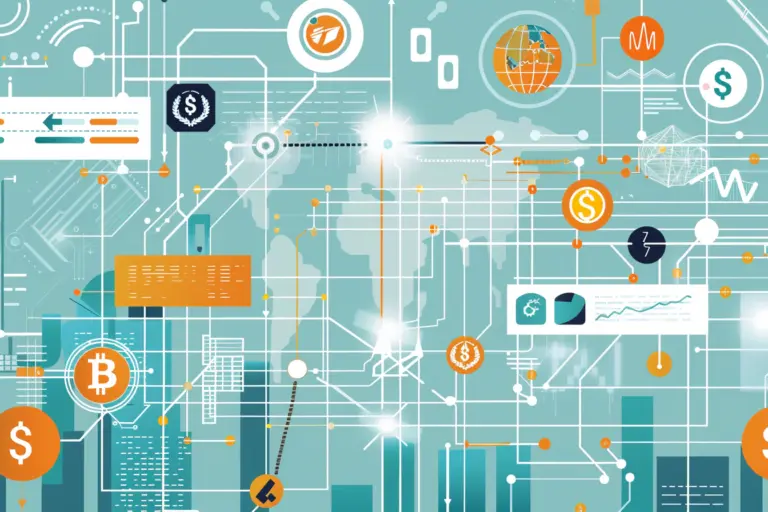In an increasingly digitized world, banks face the challenge of adapting their services to the needs and requirements of their customers. Much like online banking was a revolution in banking a few years ago, offering digital assets is now seen as a key step for banks to engage their customers and secure valuable customer assets. Analysis shows that significant amounts of customer payment flows are going to well-known crypto exchange platforms. Banks that refuse to address this issue risk not only losing important customer assets, but also weakening their position in the market.
Decentralized database as the future basic infrastructure of the financial world
Today’s basic infrastructure for financial transactions, whether in the area of payments or securities transactions, will undoubtedly undergo changes. Blockchain technology offers added value here that should not be underestimated. Its decentralized nature enables peer-to-peer transactions without the need for an intermediary. This eliminates the dependence on many intermediaries, which make the system sluggish and expensive, without actually minimizing risks. In addition, the immutability of data stored on the blockchain ensures high transaction security and integrity.
Banks need to get to grips with this technology as their customers increasingly ask for offerings in the area of trading and custody of cryptocurrencies. This is not only about attracting new customers, but also preventing potential churn. The structure of banking is changing, and banks need to understand that if they don’t enter this space now, they stand to lose.
One positive development is that there are already many established and also regulated providers in the market with whom financial houses can work closely. Be it for trading, custody, connectivity to liquidity providers or even tokenization of traditional assets. There is no longer a need to develop and implement everything themselves; instead, banks can tap into the experience and expertise of successful players in the digital asset space and form partnerships. This allows banks to enter the market quickly and efficiently, offering innovative solutions to their customers while greatly minimizing risks.
Tokenization to represent traditional and non-tradable assets.
Tokenization of shares and other physical assets is becoming increasingly important. For example, more and more financial institutions are issuing bonds based on blockchain technology. The automation of processes such as corporate actions leads to an optimization of processes such as dividend distributions, stock splits and much more. This not only reduces costs due to the elimination of manual processes, but also reduces the risks of incorrect executions or other unnecessary errors.
Another important issue is the due diligence of financial intermediaries. Unlike traditional financial flows through centralized intermediaries, blockchain technology, including cryptocurrencies, enables easier traceability of payment flows. Each transaction is verified and stored in an immutable and tamper-proof network of computers. This allows for greater transparency and traceability of transactions. This is a significant improvement over traditional financial flows, where central intermediaries can often create opaque processes and high costs. Blockchain technology thus offers a more efficient and secure way to track transactions and detect illegitimate activities, thus preventing money laundering but also terrorist financing.
Tokenization to open up new services
Tokenization allows assets to be converted into digital tokens and traded via blockchain platforms. This enables a liquid market for assets that was previously only accessible to a limited number of investors. But the benefits go far beyond access. Through the use of smart contracts and automated processes, transactions can be processed faster, more transparently and more efficiently, as mentioned earlier. This reduces costs, minimizes errors, and improves transparency. It is estimated that tokenization could lead to cost savings of up to 30% in the financial industry.
Tokenization of stocks and other physical assets opens up a huge market with enormous potential. According to estimates, the value of tokenized assets is expected to reach over $24 trillion by 2025. This includes not only traditional assets such as real estate, artwork, and company shares, but also previously non-tradable assets such as music rights, sports contracts, and more. This, of course, enables banks to offer trading and custody of digital assets.
Conclusion: Action must be taken nowt
Overall, digital assets currently offer banks the opportunity to position themselves as pioneers in the digital transformation of the financial sector. By strategically collaborating with experienced players and leveraging blockchain technology, banks can expand their services, meet customer needs, and achieve long-term success without taking unnecessary risks. It is important to recognize that the current use case of cryptocurrencies is only an intermediate step on the road to digitized equities, digital central bank currencies and a decentralized financial world.
The next step of tokenizing assets opens up a huge market with great potential for optimization. Banks that recognize and successfully implement the potential of tokenization can benefit from efficiency gains, cost reductions, and new funding opportunities.
Vision& supports, among others, banks and asset managers in building the necessary basic knowledge, making strategic decisions and exploiting the opportunities of digital assets. With our many years of experience and our broad network, we help our clients to actively shape the future of banking. From selecting the right partners to implementing tailored solutions, we accompany them on the path to digital transformation. Contact us to learn more about our services and equip your company for the digital future.




